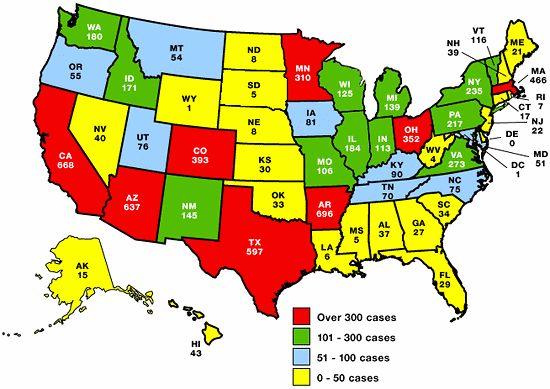What Health and Crime Maps Reveal
by Bill Sardi by Bill Sardi
I spend a great amount of my time reading articles from the National Library of Medicine, or recently published books, in my work as a health journalist. On occasion I run across some information that appears to be similar to something else I have read recently. This happened when I was researching the topic of whooping cough, which is on the rise in the U.S. The pertussis vaccine for this disease is now being widely promoted by health authorities since immunity may have worn off from inoculation years ago. I was searching for a map to show where pertussis outbreaks are concentrated. Here is the map I found.
 Pertussis (whooping cough), U.S. 2001
Pertussis (whooping cough), U.S. 2001
Days earlier, I had happened to see a map that looked similar, displaying the geographical "hot spots" for tuberculosis. Here is that map.
Both maps display concentrations of disease in southern border states, other east coast ports of entry, and selected other areas. There isn’t an environmental factor, such as stronger solar ultraviolet radiation, or water, or lifestyle that can explain these geographical similarities. Another map, involving geographical concentrations of Hepatitis A cases, also looks surprisingly similar. Here is that map for your viewing.
 Reported cases, Hepatitis A, year 2000, CDC
Reported cases, Hepatitis A, year 2000, CDC
Since these maps had such similar findings, I was curious and dug up another map, displaying the concentrations of undocumented immigrants to the USA. Here is that map.
Mulling over these maps, I wondered, is there a crime map of the U.S.? Here is the map I found.
Disease and crime are concentrated in areas where undocumented immigrants are more commonly found. An estimated 7 million undocumented immigrants now reside in the U.S. While the nation wastes its money and energy planning to thwart or combat imagined terrorism via the Department of Homeland Security, carriers of biological and other threats walk over the southern border into the U.S. on a daily basis. Over 1 million Mexicans will attempt entry this year. It’s an invasion.
Recently an outbreak of hepatitis traced to a Mexican restaurant in Pennsylvania was inexplicably traced to contaminated green onions, not the most obvious cause, undocumented food workers who harbored hepatitis. For the most part, hepatitis is a blood-borne, not a food-borne disease. The hepatitis outbreak infected over 650 individuals, caused 9000 Americans to undergo immune globulin shots, and killed 4 people. If Americans found out restaurants can commonly infect their customers from food workers, it would be a blow to the restaurant industry. Better blame the green onions. Let’s concede the onions, grown in Mexico, were contaminated from fecal material. Did all the green onions imported from Mexico end up in one single restaurant? There were no other outbreaks of hepatitis elsewhere from green onions. There were 13 restaurant workers who had hepatitis. They were the likely source of the transmitted infection.
While the unions resist mandatory hepatitis vaccination for food workers, the government mandates that newborn babies be jabbed with hepatitis vaccines before they can leave the hospital. The logic in this defies understanding until one realizes that newborn babies of immigrant families can more easily acquire hepatitis. So all the rest of American babies are given the vaccines.
The problem is with immigrant families who are not properly screened for disease as they enter the U.S. A recent study conducted by the Centers for Disease Control reveals that young infants from Hispanic families are at the greatest risk for whooping cough, presumably because the disease is transmitted from their unvaccinated family members who may have immigrated to the US from Mexico where vaccination rates are low. [Pediatric Infectious Diseases Journal 22: 628—34, 2003]
One can understand why Mexican people come to the U.S. In Mexico they are only paid $5.00 per day for their labor. When wages for Mexican workers rise, the peso is conveniently devalued to keep Mexico competitive with foreign countries like China and Thailand. The owners of Mexican businesses often keep their money in dollars in American banks and escape the devaluation of their currency. So the common people are forever doomed to poverty. America is their only hope. An article in the San Francisco Chronicle states that Mexicans living in the U.S. send between $6 and $8 billion back to their families every year, making them the third-biggest legitimate force in the Mexican economy after oil and tourism. In essence, it’s an unofficial form of foreign aid. Mexico isn’t about to control its borders, since Mexicans fleeing their country for work in the U.S. send plenty of money back to their own country.



